EU-28 Intervention Stocks Update – Nov ’16
Executive Summary
Market tools including private storage aid and intervention schemes have been made available to European dairy producers and processors since the announcement of the Russian dairy import ban in Sep ’14. Stocks have remained above seasonal levels as excess production continues to be stored away throughout the first half of the ’16-’17 production season. Highlights through the first half of the production season include:
• EU private storage aid stocks of butter and skim milk powder continue to trend higher, increasing on a YOY basis for the 22nd consecutive month during Sep ’16. Combined butter and skim milk powder private storage aid stocks of 163,000 tons finished at a 14 year high. Cheese private storage aid stocks have declined throughout five consecutive months, however, reaching an 11 month low of 19,000 tons during Sep ’16.
• Private storage aid schemes for butter and cheese were closed at the end of Sep ’16 however the skim milk powder private storage aid scheme remains open until the end of Feb ’17. Private storage aid schemes have been extended several times since being reintroduced in Sep ’14.
• Skim milk powder prices have rebounded above intervention trigger prices over recent months however sizable increases in volumes were entered into the scheme throughout the first half of 2016. Butter prices approached intervention trigger prices during Apr ’16, but have since rebounded. Similarly to private storage aid, the intervention scheme for butter closed at the end of Sep ’16 however the SMP intervention scheme was extended through the end of Dec ’16. The European Commission will then open a new 2017 intervention scheme for skim milk powder which will remain open until the end of Sep ’17.
Private Storage Aid
The European Commission reopened private storage aid (PSA) for butter, skim milk powder (SMP) and cheese during Sep ’14 in response to the expectation of price volatility generated from the sudden announcement of the Russian dairy import ban. PSA is a payment made by the European Commission to processors in return for keeping products in storage and withdrawn from the market for an agreed period of time.
In PSA schemes, processors retain ownership of the product but receive payments from the European Commission in return for keeping agreed quantities in storage and off the market. In return, processors are paid a rate of aid set by the European Commission that takes into account storage costs, normal depreciation of quality and any foreseeable increase in the price of the product. Temporary storage costs comprise of a fixed rate per ton, plus a set daily amount per ton. The product remains the property of the operators, who are then responsible for selling it when it comes out of storage.
PSA has historically been made available for only butter and SMP. PSA made available for certain types of cheese in Sep ’14 was repealed less than a month later due to a disproportionate surge in offers from cheese producing countries not traditionally exporting significant quantities of cheese to Russia. In the 18 days that the scheme was open, over 100,000 tons of cheese were offered, 84% of which was from Italy. At the end of April, only approximately 16,000 tons remained in storage under the scheme.
Most of the European Union’s additional production of dairy products has been directed into either butter or skim milk powder to utilize the PSA support provided from the European Commission. Combined butter and SMP volumes within PSA remained higher on a YOY basis for the 22nd consecutive month during Sep ’16, finishing up 41.9%. Combined butter and SMP volumes within PSA reached a 14 year high throughout the month. Individually, butter PSA stocks finished up just 1.7%, however SMP PSA stocks finished 177.3% above the previous year volumes.
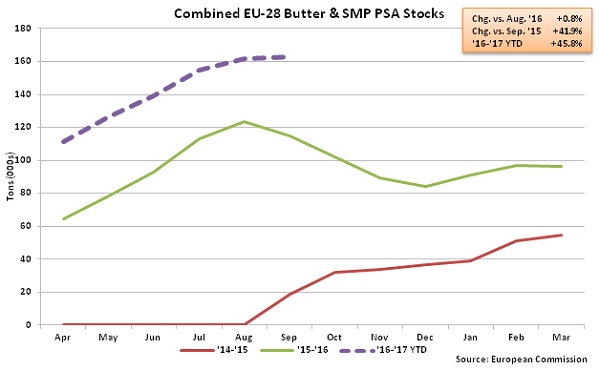 Butter stocks within PSA finished at 90,000 tons during Sep ’16, declining for the second consecutive month since peaking at 102,000 tons during Jul ’16. SMP stocks within PSA of 73,000 tons reached the highest figure on record during Sep ’16. SMP stocks within PSA have reached record highs throughout each of the past four months through September. In addition to butter and SMP, PSA for cheese was reopened during Oct ’15, allowing a maximum of 100,000 tons of cheese to be put into storage at subsidized rates, with additional volume limits for individual member states also in effect. Since opening, EU-28 PSA cheese stocks have not exceeded 33,000 tons. Cheese volumes in storage have declined over five consecutive months, reaching an 11 month low of approximately 19,000 tons during Sep ’16.
PSA schemes for butter and cheese closed at the end of Sep ’16 however the European Commission authorized extending PSA for SMP through Feb ’17. PSA schemes have been extended several times since being reintroduced in Sep ’14.
Butter stocks within PSA finished at 90,000 tons during Sep ’16, declining for the second consecutive month since peaking at 102,000 tons during Jul ’16. SMP stocks within PSA of 73,000 tons reached the highest figure on record during Sep ’16. SMP stocks within PSA have reached record highs throughout each of the past four months through September. In addition to butter and SMP, PSA for cheese was reopened during Oct ’15, allowing a maximum of 100,000 tons of cheese to be put into storage at subsidized rates, with additional volume limits for individual member states also in effect. Since opening, EU-28 PSA cheese stocks have not exceeded 33,000 tons. Cheese volumes in storage have declined over five consecutive months, reaching an 11 month low of approximately 19,000 tons during Sep ’16.
PSA schemes for butter and cheese closed at the end of Sep ’16 however the European Commission authorized extending PSA for SMP through Feb ’17. PSA schemes have been extended several times since being reintroduced in Sep ’14.
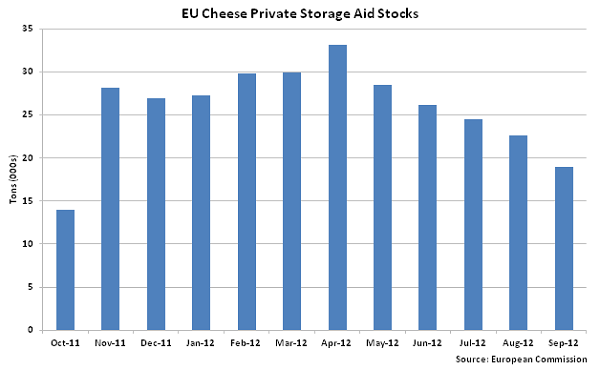 SMP can be stored for between 90 – 210 days or for 365 days within the PSA scheme. Because of the agreed upon storage durations, not all product stored within PSA is available to be withdrawn immediately without penalty. Without incurring a penalty, the largest potential withdrawal in EU-28 SMP PSA is approximately 6,000 MT, or 8.8% of total SMP volumes within PSA as of Sep ’16. Considerably less SMP is available for withdrawal due to the implementation of the 365 day storage program announced during Oct ’15. The 365 day storage program provides a higher rate of aid in exchange for keeping the product off of the market for a longer duration. Over 51,000 MT of SMP has been offered into the 365 day storage program since it was initiated.
SMP can be stored for between 90 – 210 days or for 365 days within the PSA scheme. Because of the agreed upon storage durations, not all product stored within PSA is available to be withdrawn immediately without penalty. Without incurring a penalty, the largest potential withdrawal in EU-28 SMP PSA is approximately 6,000 MT, or 8.8% of total SMP volumes within PSA as of Sep ’16. Considerably less SMP is available for withdrawal due to the implementation of the 365 day storage program announced during Oct ’15. The 365 day storage program provides a higher rate of aid in exchange for keeping the product off of the market for a longer duration. Over 51,000 MT of SMP has been offered into the 365 day storage program since it was initiated.
 Intervention Schemes
Intervention schemes, involving selling quantities of products into government owned storage to help stabilize prices, have also been made available to EU-28 dairy producers. Intervention schemes are similar to PSA, as both help to stabilize markets by removing excess supply when prices decline. This can be temporary, where the product is later re-released for sale within the EU, or permanent, where the product is eventually exported from the EU.
Under intervention schemes, the European Commission purchases up to a designated volume of butter and SMP and, if exceeded, a tendering process takes place for additional volumes. Intervention schemes can be seasonal or in response to exceptional market conditions. The intervention scheme is typically open from the beginning of March until the end of September each year, although the 2015 scheme was extended until the end of Dec ’15 due to adverse market conditions. A new intervention campaign was then immediately reopened in Jan ’16 with volume limits reset, due to remain open until the end of Sep ’16.
The trigger price for butter intervention is €2,218/ton ($1.12/lb equivalent using a 0.90 USD/EUR exchange rate), while the SMP intervention trigger price is set at €1,698/ton ($0.86/lb equivalent using a 0.90 USD/EUR exchange rate). As of Oct 27th, average European butter prices were 89.5% above the intervention trigger price while average SMP prices were 22.4% above the intervention trigger price.
Intervention Schemes
Intervention schemes, involving selling quantities of products into government owned storage to help stabilize prices, have also been made available to EU-28 dairy producers. Intervention schemes are similar to PSA, as both help to stabilize markets by removing excess supply when prices decline. This can be temporary, where the product is later re-released for sale within the EU, or permanent, where the product is eventually exported from the EU.
Under intervention schemes, the European Commission purchases up to a designated volume of butter and SMP and, if exceeded, a tendering process takes place for additional volumes. Intervention schemes can be seasonal or in response to exceptional market conditions. The intervention scheme is typically open from the beginning of March until the end of September each year, although the 2015 scheme was extended until the end of Dec ’15 due to adverse market conditions. A new intervention campaign was then immediately reopened in Jan ’16 with volume limits reset, due to remain open until the end of Sep ’16.
The trigger price for butter intervention is €2,218/ton ($1.12/lb equivalent using a 0.90 USD/EUR exchange rate), while the SMP intervention trigger price is set at €1,698/ton ($0.86/lb equivalent using a 0.90 USD/EUR exchange rate). As of Oct 27th, average European butter prices were 89.5% above the intervention trigger price while average SMP prices were 22.4% above the intervention trigger price.
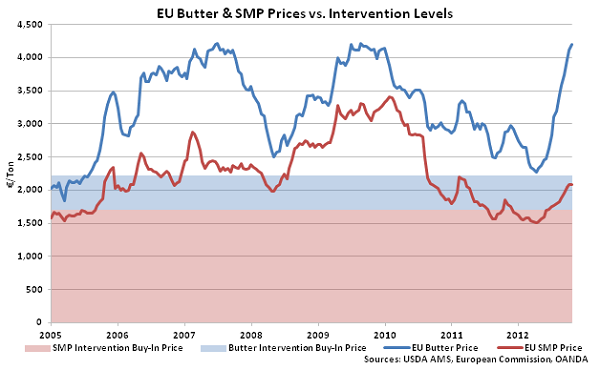 EU-28 butter prices approached intervention trigger price levels during Apr ’16 but have since rebounded by nearly 85%. SMP prices declined below intervention trigger prices over the first half of 2016 however prices have rebounded to above intervention trigger price levels since the beginning of Aug ’16.
EU-28 butter prices approached intervention trigger price levels during Apr ’16 but have since rebounded by nearly 85%. SMP prices declined below intervention trigger prices over the first half of 2016 however prices have rebounded to above intervention trigger price levels since the beginning of Aug ’16.
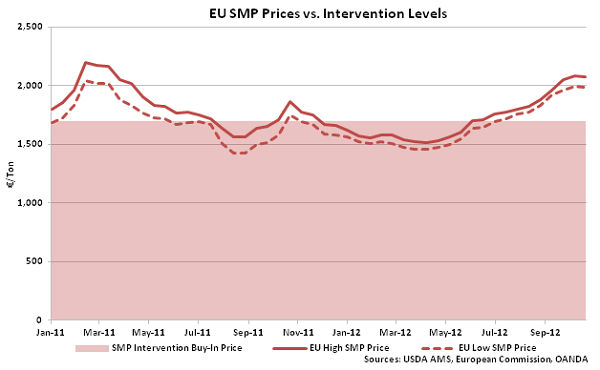 EU-28 SMP offered into intervention has risen dramatically since the beginning of 2016 as prices remained below the intervention buy-in trigger price over much of the year. The intervention schemes originally allowed for up to 60,000 tons of butter and 109,000 tons of SMP to be brought at the designated intervention prices. After the SMP intervention limit was reached in Apr ’16, the European Commission raised the volume ceiling for the 2016 campaign to 218,000 tons, citing ongoing market difficulties. The 218,000 capacity was reached by Jun ’16, when the ceiling was again raised, this time to 350,000 tons of SMP.
EU-28 SMP offered into intervention has risen dramatically since the beginning of 2016 as prices remained below the intervention buy-in trigger price over much of the year. The intervention schemes originally allowed for up to 60,000 tons of butter and 109,000 tons of SMP to be brought at the designated intervention prices. After the SMP intervention limit was reached in Apr ’16, the European Commission raised the volume ceiling for the 2016 campaign to 218,000 tons, citing ongoing market difficulties. The 218,000 capacity was reached by Jun ’16, when the ceiling was again raised, this time to 350,000 tons of SMP.
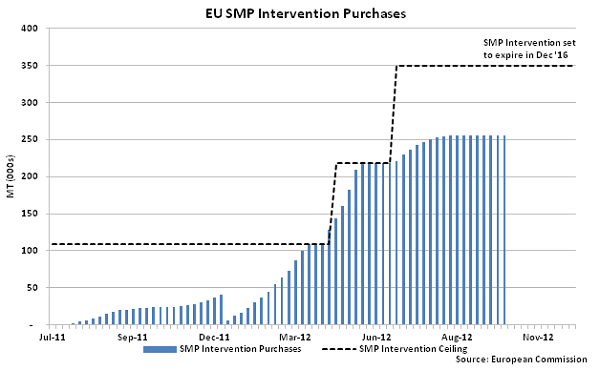 Similarly to PSA, the intervention scheme for butter closed at the end of Sep ’16 however the European Commission extended the intervention scheme for SMP through the end of Dec ’16. It will then open a new 2017 scheme for SMP, which will be available until the end of Sep ’17. SMP intervention purchases have recently approached the 25 year high of 260,000 tons experienced during 2009. Current volumes of 256,000 tons are in addition to 78,000 tons of SMP bought in via tender during Apr ’16 and Jun ’16 when offers exceeded the previous ceiling levels.
Similarly to PSA, the intervention scheme for butter closed at the end of Sep ’16 however the European Commission extended the intervention scheme for SMP through the end of Dec ’16. It will then open a new 2017 scheme for SMP, which will be available until the end of Sep ’17. SMP intervention purchases have recently approached the 25 year high of 260,000 tons experienced during 2009. Current volumes of 256,000 tons are in addition to 78,000 tons of SMP bought in via tender during Apr ’16 and Jun ’16 when offers exceeded the previous ceiling levels.
 Butter stocks within PSA finished at 90,000 tons during Sep ’16, declining for the second consecutive month since peaking at 102,000 tons during Jul ’16. SMP stocks within PSA of 73,000 tons reached the highest figure on record during Sep ’16. SMP stocks within PSA have reached record highs throughout each of the past four months through September. In addition to butter and SMP, PSA for cheese was reopened during Oct ’15, allowing a maximum of 100,000 tons of cheese to be put into storage at subsidized rates, with additional volume limits for individual member states also in effect. Since opening, EU-28 PSA cheese stocks have not exceeded 33,000 tons. Cheese volumes in storage have declined over five consecutive months, reaching an 11 month low of approximately 19,000 tons during Sep ’16.
PSA schemes for butter and cheese closed at the end of Sep ’16 however the European Commission authorized extending PSA for SMP through Feb ’17. PSA schemes have been extended several times since being reintroduced in Sep ’14.
Butter stocks within PSA finished at 90,000 tons during Sep ’16, declining for the second consecutive month since peaking at 102,000 tons during Jul ’16. SMP stocks within PSA of 73,000 tons reached the highest figure on record during Sep ’16. SMP stocks within PSA have reached record highs throughout each of the past four months through September. In addition to butter and SMP, PSA for cheese was reopened during Oct ’15, allowing a maximum of 100,000 tons of cheese to be put into storage at subsidized rates, with additional volume limits for individual member states also in effect. Since opening, EU-28 PSA cheese stocks have not exceeded 33,000 tons. Cheese volumes in storage have declined over five consecutive months, reaching an 11 month low of approximately 19,000 tons during Sep ’16.
PSA schemes for butter and cheese closed at the end of Sep ’16 however the European Commission authorized extending PSA for SMP through Feb ’17. PSA schemes have been extended several times since being reintroduced in Sep ’14.
 SMP can be stored for between 90 – 210 days or for 365 days within the PSA scheme. Because of the agreed upon storage durations, not all product stored within PSA is available to be withdrawn immediately without penalty. Without incurring a penalty, the largest potential withdrawal in EU-28 SMP PSA is approximately 6,000 MT, or 8.8% of total SMP volumes within PSA as of Sep ’16. Considerably less SMP is available for withdrawal due to the implementation of the 365 day storage program announced during Oct ’15. The 365 day storage program provides a higher rate of aid in exchange for keeping the product off of the market for a longer duration. Over 51,000 MT of SMP has been offered into the 365 day storage program since it was initiated.
SMP can be stored for between 90 – 210 days or for 365 days within the PSA scheme. Because of the agreed upon storage durations, not all product stored within PSA is available to be withdrawn immediately without penalty. Without incurring a penalty, the largest potential withdrawal in EU-28 SMP PSA is approximately 6,000 MT, or 8.8% of total SMP volumes within PSA as of Sep ’16. Considerably less SMP is available for withdrawal due to the implementation of the 365 day storage program announced during Oct ’15. The 365 day storage program provides a higher rate of aid in exchange for keeping the product off of the market for a longer duration. Over 51,000 MT of SMP has been offered into the 365 day storage program since it was initiated.
 Intervention Schemes
Intervention schemes, involving selling quantities of products into government owned storage to help stabilize prices, have also been made available to EU-28 dairy producers. Intervention schemes are similar to PSA, as both help to stabilize markets by removing excess supply when prices decline. This can be temporary, where the product is later re-released for sale within the EU, or permanent, where the product is eventually exported from the EU.
Under intervention schemes, the European Commission purchases up to a designated volume of butter and SMP and, if exceeded, a tendering process takes place for additional volumes. Intervention schemes can be seasonal or in response to exceptional market conditions. The intervention scheme is typically open from the beginning of March until the end of September each year, although the 2015 scheme was extended until the end of Dec ’15 due to adverse market conditions. A new intervention campaign was then immediately reopened in Jan ’16 with volume limits reset, due to remain open until the end of Sep ’16.
The trigger price for butter intervention is €2,218/ton ($1.12/lb equivalent using a 0.90 USD/EUR exchange rate), while the SMP intervention trigger price is set at €1,698/ton ($0.86/lb equivalent using a 0.90 USD/EUR exchange rate). As of Oct 27th, average European butter prices were 89.5% above the intervention trigger price while average SMP prices were 22.4% above the intervention trigger price.
Intervention Schemes
Intervention schemes, involving selling quantities of products into government owned storage to help stabilize prices, have also been made available to EU-28 dairy producers. Intervention schemes are similar to PSA, as both help to stabilize markets by removing excess supply when prices decline. This can be temporary, where the product is later re-released for sale within the EU, or permanent, where the product is eventually exported from the EU.
Under intervention schemes, the European Commission purchases up to a designated volume of butter and SMP and, if exceeded, a tendering process takes place for additional volumes. Intervention schemes can be seasonal or in response to exceptional market conditions. The intervention scheme is typically open from the beginning of March until the end of September each year, although the 2015 scheme was extended until the end of Dec ’15 due to adverse market conditions. A new intervention campaign was then immediately reopened in Jan ’16 with volume limits reset, due to remain open until the end of Sep ’16.
The trigger price for butter intervention is €2,218/ton ($1.12/lb equivalent using a 0.90 USD/EUR exchange rate), while the SMP intervention trigger price is set at €1,698/ton ($0.86/lb equivalent using a 0.90 USD/EUR exchange rate). As of Oct 27th, average European butter prices were 89.5% above the intervention trigger price while average SMP prices were 22.4% above the intervention trigger price.
 EU-28 butter prices approached intervention trigger price levels during Apr ’16 but have since rebounded by nearly 85%. SMP prices declined below intervention trigger prices over the first half of 2016 however prices have rebounded to above intervention trigger price levels since the beginning of Aug ’16.
EU-28 butter prices approached intervention trigger price levels during Apr ’16 but have since rebounded by nearly 85%. SMP prices declined below intervention trigger prices over the first half of 2016 however prices have rebounded to above intervention trigger price levels since the beginning of Aug ’16.
 EU-28 SMP offered into intervention has risen dramatically since the beginning of 2016 as prices remained below the intervention buy-in trigger price over much of the year. The intervention schemes originally allowed for up to 60,000 tons of butter and 109,000 tons of SMP to be brought at the designated intervention prices. After the SMP intervention limit was reached in Apr ’16, the European Commission raised the volume ceiling for the 2016 campaign to 218,000 tons, citing ongoing market difficulties. The 218,000 capacity was reached by Jun ’16, when the ceiling was again raised, this time to 350,000 tons of SMP.
EU-28 SMP offered into intervention has risen dramatically since the beginning of 2016 as prices remained below the intervention buy-in trigger price over much of the year. The intervention schemes originally allowed for up to 60,000 tons of butter and 109,000 tons of SMP to be brought at the designated intervention prices. After the SMP intervention limit was reached in Apr ’16, the European Commission raised the volume ceiling for the 2016 campaign to 218,000 tons, citing ongoing market difficulties. The 218,000 capacity was reached by Jun ’16, when the ceiling was again raised, this time to 350,000 tons of SMP.
 Similarly to PSA, the intervention scheme for butter closed at the end of Sep ’16 however the European Commission extended the intervention scheme for SMP through the end of Dec ’16. It will then open a new 2017 scheme for SMP, which will be available until the end of Sep ’17. SMP intervention purchases have recently approached the 25 year high of 260,000 tons experienced during 2009. Current volumes of 256,000 tons are in addition to 78,000 tons of SMP bought in via tender during Apr ’16 and Jun ’16 when offers exceeded the previous ceiling levels.
Similarly to PSA, the intervention scheme for butter closed at the end of Sep ’16 however the European Commission extended the intervention scheme for SMP through the end of Dec ’16. It will then open a new 2017 scheme for SMP, which will be available until the end of Sep ’17. SMP intervention purchases have recently approached the 25 year high of 260,000 tons experienced during 2009. Current volumes of 256,000 tons are in addition to 78,000 tons of SMP bought in via tender during Apr ’16 and Jun ’16 when offers exceeded the previous ceiling levels.